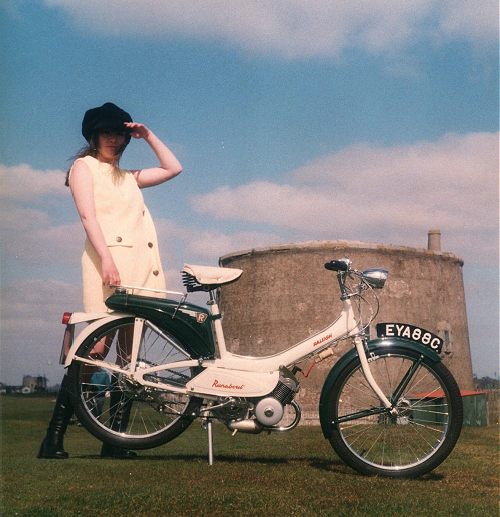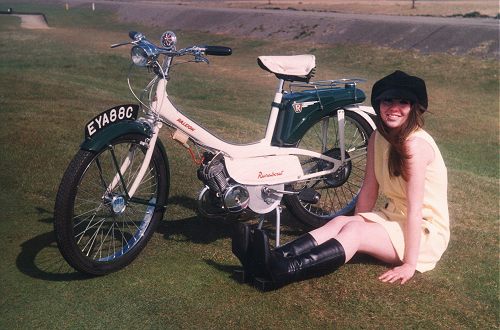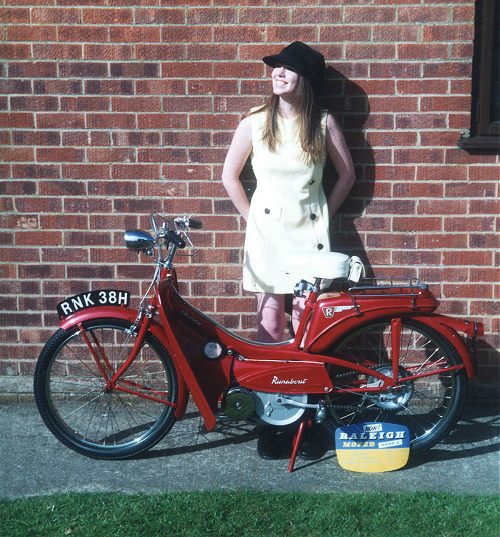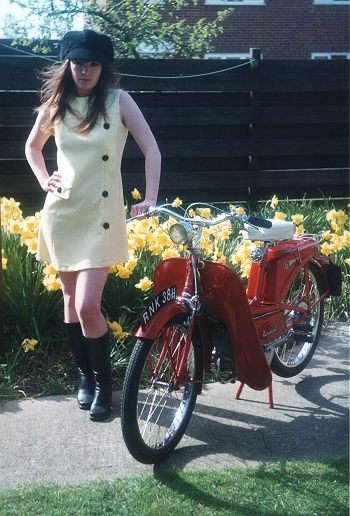 Go
to the Archive index
Go
to the Archive index
Runabout and Rhoda on lookout before Martello 'S' Tower,
'T' Tower is in the distance at Ferry Hamlet
Matthew, Chapter 5, Verse 5 - "The meek shall inherit the Earth", and this innocuous little machine did just that from the day of its launch at the Winter Gardens Show in Blackpool on 15th May 1963. Described at the time by Power and Pedal as "Probably the most practical, the simplest and even the prettiest utility moped ever to appear in Britain", the public agreed unanimously and bought the bike on a scale that staggered the dealers. Cox's Motorcycles in provincial Ipswich actually sold 30 machines on just one Saturday! The era of the Raleigh Runabout had arrived.
The rigid-rear pressed steel Motobécane frame was practically identical to the preceding RM4 model, but featured extensively revised fittings to reduce the new machine's basic cost. The telescopic legs of the RM4 were substituted by a heavy-duty rigid fork and Sturmey cycle hub with calliper brake working on the Dunlop Endrick rim. Home-baked rounded profile mudguards became supplanted in place of the Motobécane valanced ones, with the Runabout's 11 pint capacity rear mounted tank superseding the oval "Lido" pattern of the RM4 (that had originated at Achilles in Germany, and Raleigh inherited from Norman in 1960 with the group merger). New economic side-panel pressings minimised these items from the RM4, while all British cycle industry components covered the controls and headlamp: Wipac and Miller usually supplied the taillight, though a small number of Lucas units were also used.
For a licence factored machine, the Runabout comprised a significant proportion of home produced components and it was probably easier just to identify the few French sourced parts as frame, engine unit, flywheel and rear hub. It was cheap, really cheap: actually undercutting its nearest competitor (ironically Mobylette's own Monoluxe) by nearly 14%! Practical and reliable, it looked super in its smart green and white livery - and even 40 years later at its Ruby Anniversary, everyone still loves the Runabout. It's the mopeding version of the Morris Minor!

Rhoda and Runabout
So successful was this formula that it formed the core of Raleigh's range for several years, and spawned a whole family of spin-off variant RM6 models, in style, colours and fittings, as well as the tele-forked RM8, vario 9 & 9+1 (10), the rare RM11 Super Tourist and sporty RM12.
Approaching a Runabout is like greeting an old friend; many people have owned one, most have ridden one at some time, and everybody knows them. Today's test bike in the classic Raleigh Green and Pearl Grey (white shade) colour scheme perfectly typifies this iconic model.
Registered in July of 1965, and restored over the winter of 2000/1, it now features a 1.7bhp split-fin replacement motor where the original would actually have been the 1.4bhp continuous fin. Everything about the friendly little machine draws you to it like countless thousands of customers attracted by its charm, "look at my honest construction, obviously simple to operate, so easy to ride - come and try!" Oh alright (but really, how could anyone resist?) A Karco lever fuel tap at bottom right of the tank gets the juice flowing, trigger choke, forward decompress and push down on a pedal. As the motor starts turning just pull back on the throttle and the engine's smoothly away first time. A couple of further flicks on the choke and the running quickly settles down to a steady tickover beat. Nudge off the stand and mounting to ride is just so easy with the low step-through frame, then settling into position with such familiar cycle-like controls. From the lower riding position due to the 23" diameter wheels and their firm footed 2" wide width, confident impressions were conveyed to the first time rider - yes, I could manage one of these! Cycle style brakes to stop and just throttle to go, smoothly away on the automatic clutch and it's just as easy as riding a bicycle. No, easier - you don't have to pedal! The motor's low state of tune with its 7.5:1 compression ratio, BA10mm Gurtner carburettor, and 1.7bhp make the bike totally docile and clean running at all operating speeds. The engine tickover is slow and regular, while it really is so relaxing just droning along country lanes to the mellow, popping exhaust note.
The basic models came essentially fitted only, but you could purchase a number of accessories to dress it up: speedometer, tyre inflator, chromium rear carrier, electric horn kit, leg-shields, windscreen and panniers. Despite the lack of suspension the ride is quite reasonable at moderate speeds with pneumatic balloon tyres and sprung saddle absorbing most effects. As the pace is raised towards 30mph however, you must expect to start receiving more feedback from the road surface. The cycle front brake is pretty much adequate for general requirements, as long as you don't start pushing things too much and too often. A top speed up to 35mph may be achieved under ideal conditions, while the proven Moby engine is dead reliable and lights adequate for the performance. The Raleigh really is a very capable Runabout, adequate in all ways, and that's just what you should expect from the basic RM6 model. If you're after a slightly more comfortable ride, a little more performance, then simply select a higher rated model from the comprehensive Raleigh range.

Rhoda models the top of the Runabout range -
an RM6 Super DeLuxe with all the trimmings
The Runabout is a great machine to restore today, most parts are readily available to make the task quite straightforward, and you will be rewarded with a practical and reliable little classic that will be widely loved by all that see it. The sheer volume of sales and immense popularity of the Runabout surely earns it a podium place in the moped Hall of Fame. Nearly some 200,000 Motobécane engined machines of all RM models were made, the greater majority of which belonged to the Runabout family. EMI came close, producing towards 170,000 Cyclemasters, while the mighty BSA only managed some 27,000 Winged Wheels, then even more surprisingly, a mere 15,000 autocycles under the New Hudson brand!
The earliest RM6 machines were fitted with the 1.4bhp continuous fin barrel motor and 6.5:1 compression ratio, but gave way to the 1.7bhp version for 1966. Optional colour schemes followed with blue & white, red & white, Neptune (turquoise) blue for 1966 only, Royal (dark) blue from 1967 on, Royal Carmine red (metallic) for RM6 Deluxe and Super Deluxe, and even the all-black of the budget priced "Pop" model listed briefly from October 1966 to February 1967, but none repeated the enormous popularity of that original classic green & white combination. The RM8 introduced in March 1964 featured telescopic forks and better lighting. The RM9 Ultramatic followed in April, claiming a 2bhp motor and vario transmission, while the RM9+1 (10) was merely a dual seat version of the same model. Real performance arrived for the Runabout in June 1965 with the arrival of the AV89 powered RM12 Super50 sports moped. If you wanted this 2.7bhp without the drop handlebars and boy-racer image, the RM11 Super Tourist briefly became listed from January 1966 to July 1967, achieving its dubious position as Raleigh's lowest selling model. As the rest of the RM variants steadily followed it into history, the Runabout range progressively shrank back to its original model, which soldiered on alone with a revised frame numbering system, till finally becoming de-listed in February 1971.
It was Raleigh's last motorised product.

As surely as one sun sets, the following day another rises in the East. The Vapours could play in this last true pedal moped with a 4-stroke engine. No officer, the clues couldn't get any easier!
First published, June 2003